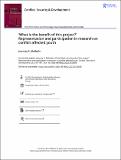Files in this item
‘What is the benefit of this project?’ Representation and participation in research on conflict-affected youth
Item metadata
| dc.contributor.author | McMullin, Jaremey | |
| dc.date.accessioned | 2022-11-16T17:30:02Z | |
| dc.date.available | 2022-11-16T17:30:02Z | |
| dc.date.issued | 2022-10-20 | |
| dc.identifier | 281272744 | |
| dc.identifier | 63312a14-c3e6-4e39-8d71-262634ba2b30 | |
| dc.identifier | 85141048325 | |
| dc.identifier | 000870648100001 | |
| dc.identifier.citation | McMullin , J 2022 , ' ‘What is the benefit of this project?’ Representation and participation in research on conflict-affected youth ' , Conflict, Security & Development , vol. 22 , no. 5 , pp. 517–541 . https://doi.org/10.1080/14678802.2022.2122698 | en |
| dc.identifier.issn | 1467-8802 | |
| dc.identifier.other | ORCID: /0000-0002-0444-3146/work/123195625 | |
| dc.identifier.uri | https://hdl.handle.net/10023/26414 | |
| dc.description | Funding: The work was supported by the Folke Bernadotte Academy, the Swedish government agency for peace, security and development, under Grant 20-00280; and the Scottish Funding Council under Grants SFC/AN/12/2017, SFC/AN/02/2018, SFC/AN/04/2019 and SFC/AN/18/2020. | en |
| dc.description.abstract | This article deploys the language, narratives and proposed solutions of research participants to conceptualise peace research as a representational and relational process of recognition. To do so, it draws from a multi-year research project on the economic livelihood and social integration strategies of conflict-affected youth in Liberia’s commercial motorcycling sector. Its starting point is reflexive engagement with participants’ own frequent question: ‘What is the benefit of this project?’ It advocates for participatory approaches to the time-spaces that ex-combatant and conflict-affected youth actually inhabit (rather than those scripted or desired for them by more traditional forms of peace research). It applies critical peace-building insights about time to contribute to conceptualisations of post-conflict ‘reintegration trajectories’ that question ideas about who builds peace, and how. It argues that participatory research brings issues of social stigma, objectification and marginalisation to the fore. And, it explores the methodological implications of participatory research, identifying the ways in which sited ethnography, relational interviewing and narrative approaches can centre research-as-recognition. Participatory approaches make peace researchable not just to collect lived experiences (treating research as transactional data collection) but to implement participants’ own ideas about peace-building strategies and solutions (treating peace research as relational recognition and something that is mutually beneficial). | |
| dc.format.extent | 25 | |
| dc.format.extent | 814152 | |
| dc.language.iso | eng | |
| dc.relation.ispartof | Conflict, Security & Development | en |
| dc.subject | Peace-building | en |
| dc.subject | Conflict affected youth | en |
| dc.subject | Participatory action research | en |
| dc.subject | Excombatant reintegration | en |
| dc.subject | DDR | en |
| dc.subject | JZ International relations | en |
| dc.subject | T-NDAS | en |
| dc.subject | MCC | en |
| dc.subject.lcc | JZ | en |
| dc.title | ‘What is the benefit of this project?’ Representation and participation in research on conflict-affected youth | en |
| dc.type | Journal article | en |
| dc.contributor.sponsor | Scottish Funding Council | en |
| dc.contributor.sponsor | Scottish Funding Council | en |
| dc.contributor.institution | University of St Andrews. School of International Relations | en |
| dc.identifier.doi | 10.1080/14678802.2022.2122698 | |
| dc.description.status | Peer reviewed | en |
| dc.identifier.grantnumber | SFC/AN/12/2017 | en |
| dc.identifier.grantnumber | N/A | en |
This item appears in the following Collection(s)
Items in the St Andrews Research Repository are protected by copyright, with all rights reserved, unless otherwise indicated.

